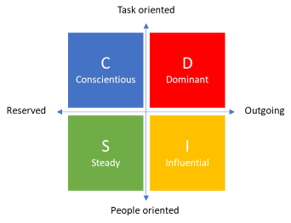If you are new to the idea of Team Praxis, please read our introduction to the concept before using the table below to improve your communications with team members, stakeholders and anyone else involved in your project, programme or portfolio.
 The goals of control are to:
The goals of control are to:
- review performance against baselines;
- evaluate the effect of actual performance on future plans;
- take action as required to achieve planning targets or agree revised targets.
When implementing these goals people with different character traits would perceive control management plans and techniques in different ways.
 Concientious behaviour would typically propose or want to see: Concientious behaviour would typically propose or want to see:
-
rigorous and frequent monitoring and reviews directly against detailed baselines; -
comprehensive evaluation of the impact on future plans based on historical data and in particular on any increased risk; -
comprehensive updating of documentation and formal communication with the team and confirmation of receipt and acceptance; -
a formal definition as to how targets will be met and the actions necessary to achieve them. Someone exhibiting concientious behaviour would typically be perceived as: -
requiring a formalised, comprehensive and rigorous approach to control; -
seeking perfection through taking their time to monitor carefully and carry out detailed reviews; -
formal and happier to be working on their own when monitoring progress against past performance. |  Dominant behaviour would typically propose or want to see: Dominant behaviour would typically propose or want to see:
-
an efficient and focused process for assessing performance against key metrics and reference back to the baseline if necessary; -
a high-level evaluation of the impact on future targets identifying as quickly as possible any underperformance; -
updating of documents only when necessary and clear communication to people of any new expectations on them; - individuals and teams made accountable for the actions necessary for the achievement of targets.
Someone exhibiting dominant behaviour would typically be perceived as: -
wishing to minimise the effort on monitoring, maximise the effort on delivery and to ensure they are in control; -
happy to make decisions regarding the action that should be taken to ensure that performance is not impacted; -
challenging what they are told and always seeking ways to deliver more efficiently to meet targets. |
 Steady behaviour would typically propose or want to see: Steady behaviour would typically propose or want to see:
-
thorough and regular reviews carried out with the individuals involved, to provide feedback, with reference back to baselines; -
detailed evaluation of the impact on future plans and people and the challenges this may create; -
the updating of documentation and a clear process for communicating this to people and confirmation of them understanding the changes; - an inclusive approach to agree how targets will be met by individuals considering any challenges they may have.
Someone exhibiting steady behaviour would typically be perceived as: -
diligent and supportive when monitoring progress and considerate of the impact on others of decisions that may need to be made to ensure targets are met; -
co-operative, easy to approach and supportive around the process of monitoring and happy to input to help others. |  Influential behaviour would typically propose or want to see: Influential behaviour would typically propose or want to see:
-
a relaxed and informal approach to monitoring with infrequent reference to the baseline; -
a collaborative approach to the evaluation of the impact on any changes to plans; -
the infrequent updating of documents when the team feel that formalising what has been shared and discussed is necessary; - key individuals and teams discussing and agreeing the actions necessary for achieving targets.
Someone exhibiting influential behaviour would typically be perceived as: -
taking an informal and collaborative approach to monitoring and the necessary control actions; -
keen to explore all options when decisions are necessary to meet targets; -
comfortable to make decisions in a dynamic environment where there is considerable uncertainty. |
Thanks to Donnie MacNicol of Team Animation for providing this page.
 The goals of control are to:
The goals of control are to:
 Concientious behaviour would typically propose or want to see:
Concientious behaviour would typically propose or want to see: Dominant behaviour would typically propose or want to see:
Dominant behaviour would typically propose or want to see: Steady behaviour would typically propose or want to see:
Steady behaviour would typically propose or want to see: Influential behaviour would typically propose or want to see:
Influential behaviour would typically propose or want to see:



